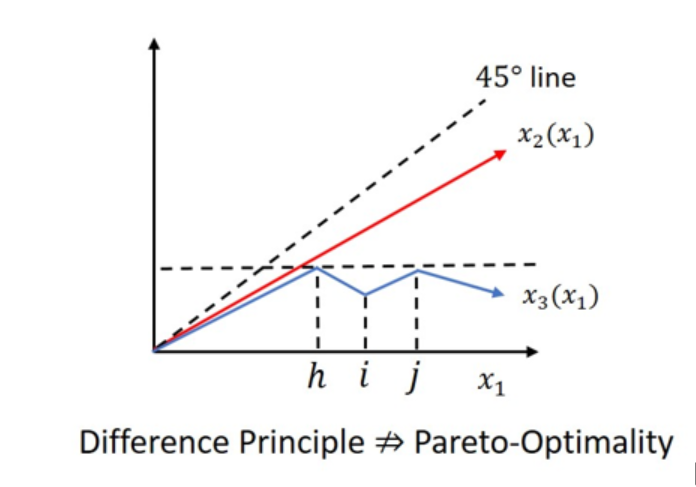John Rawls (1921 – 2002) was one of the most (if not the most) prominent political philosophers in the 20th century. Rawls proposed a theory of justice, which he called Justice as Fairness. Justice as Fairness consists of two basic principles. The first principle (known as the liberty principle) states that everybody should be guaranteed a fully adequate scheme of basic rights and liberties that are compatible with others. The second principle is designed to regulate social and economic inequalities and is comprised of two sub-principles: the principle of fair equal opportunity and the difference principle. The principle of fair equal opportunity requires that everybody, regardless of their social or economic background, should be given a fair and equal chance to succeed and occupy various positions and offices that generate social and economic inequalities. The difference principle states that any resulting social and/or economic inequalities can be justified only if it provides the greatest benefit to the least advantaged group in society.
Rawls’s difference principle targets a specific group, viz., the least advantaged group, and requires its expectations (of how well-off it is) to be maximized. One natural worry is whether the practical application of the difference principle comes with a significant cost to other groups in society. That is, what if maximizing the expectation of the least advantaged group can be achieved only by significantly lowering the expectations of all other groups? If this is the case, then this would make the difference principle less practically appealing.
Rawls was quite aware of this potential worry and gave his earnest efforts to respond to it. His solution comes from his notions of chain connection and close-knitness. A society is chain-connected if improving the situation of the least advantaged group will also improve the situation of all other groups. A society is close-knit if any change in the situation of some group will necessarily affect a change in the situation of all other groups. Rawls’s basic claim was that whenever society meets the liberty principle and the principle of fair equal opportunity, this will make society both chain-connected and close-knit, and whenever society is both chain-connected and close-knit, the difference principle will improve the situation of not just the least-advantaged group but all groups in each step of its practical implementation and eventually reach a Pareto optimal state.
In my paper, “Chain-Connection, Close-Knitness, and the Difference Principle,” I argue that Rawls’s conjecture is incorrect. I demonstrate this by utilizing a similar graphical model that Rawls himself employs in his book. First, consider the following figure which corresponds to Figure 3 of my paper.

Let me explain how to read the figure. Assume that there are three representative groups in society: $x_1$ denotes the most favored group, $x_2$ denotes the middle group, and $x_3$ denotes the least advantaged group. The horizontal axis measures the expectations of the most favored group $x_1$, while the vertical axis measures the expectations of the two other groups $x_2$ and $x_3$. The two graphs $x_2 (x_1)$ and $x_3 (x_1)$ show how the expectations of the middle group and the least advantaged group change by increasing the expectations of the most favored group $x_1$.
We can confirm that the society depicted in Figure 3 is both chain-connected and close-knit – viz., we can see that whenever the expectations of the least advantage groups $x_3$ rise, the expectations of the other two groups (i.e. the middle group $x_2$ and the most favored group $x_1$) also rise (satisfying chain connection); and that there are no flat stretches in the graphs of $x_2 (x_1)$ and $x_3 (x_1)$ (satisfying close-knit). In the figure, starting from the point of origin (what Rawls calls “the hypothetical position of equality”), Rawls’s difference principle requires our society to raise the welfare levels of the most advantaged group $x_1$ up to it reaches the point j at which the expectations of the least advantaged group $x_3$ are maximized. However, doing so requires our society to go through sections d to e, during which the expectations of the least advantaged group $x_3$ falls. Hence, the satisfaction of both chain-connection and close-knitness does not necessarily guarantee that the difference principle will improve the expectations of everybody in each step of its practical implementation contrary to what Rawls claimed.
Now, consider the next figure, which corresponds to Figure 4 of my paper.

Just like it was the case for Figure 3, the society depicted in Figure 4 is both chain-connected and close-knit. The expectations of the least advantaged group are maximized either at point h or at point j. Hence, both points h and j are compatible with the prescriptions of the difference principle. However, point h is not Pareto optimal: at point h, it is possible to improve the expectations of some group (actually, both the middle group and the most favored group) without worsening the expectations of any group. This is because point h is Pareto dominated by point j. This shows that the satisfaction of both chain-connection and close-knitness does not guarantee that the final social state prescribed by the difference principle will always be Pareto optimal.
We may try to solve this problem by considering the version of the difference principle that would exclude point h and make point j its unique prescription. This version is what Rawls calls “the lexical difference principle.” However, the lexical difference principle confronts the following problems are: (a) it does not guarantee Pareto improvements so it does not solve the problem completely; (b) it fails to provide continuous ethical judgments meaning that it may fail to treat extremely similar cases alike; and (c) it defeats one of the main purposes for Rawls to introduce the notions of chain connection and close-knit in the first place.
The discussion in my paper gives us reasons to reconsider the status of the difference principle (as well as its lexicographic variant) as forming an integral part of justice as fairness.
This blog piece is based on the article “Chain-Connnection, Close-knitness, and the Difference Principle” by Hun Chung, forthcoming in the Journal of Politics, October 2022.
About the author
Hun Chung- Waseda University

Hun Chung is an Associate Professor of the Faculty of Political Science and Economics at Waseda University. He has received his first Ph.D. in Philosophy at Cornell University and his second Ph.D. in Political Science at the University of Rochester. He works at the intersections of formal political theory (game/social choice theory) and political philosophy – in short, PPE (Philosophy, Politics, and Economics). You can find further information regarding his research on his website.


